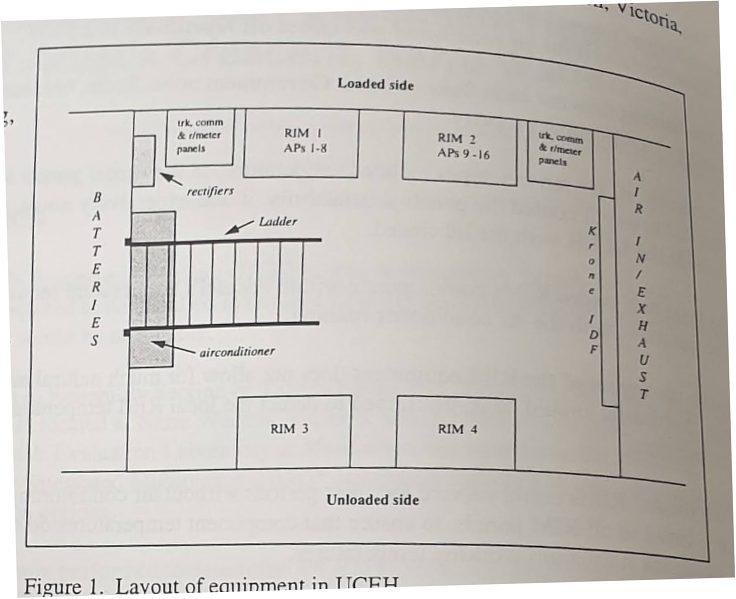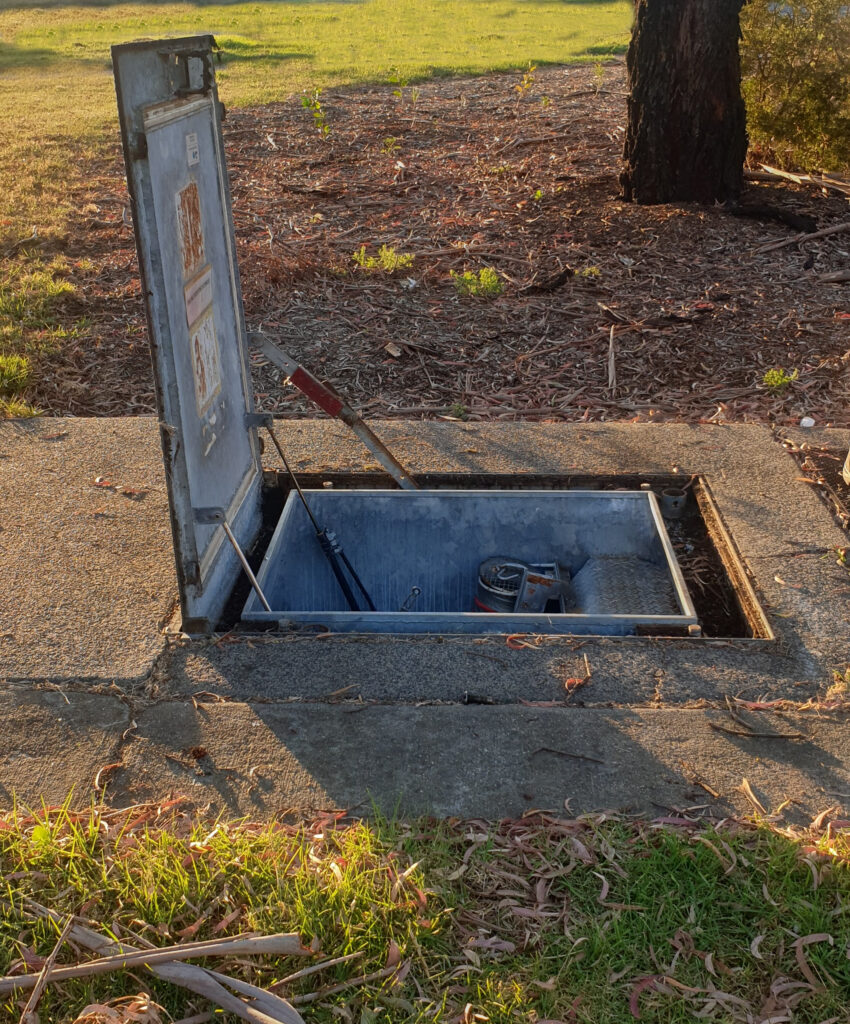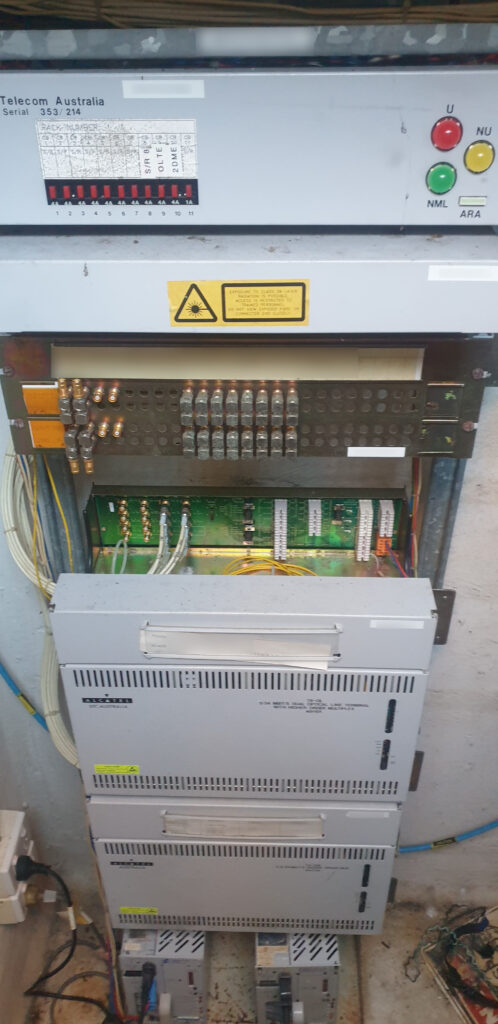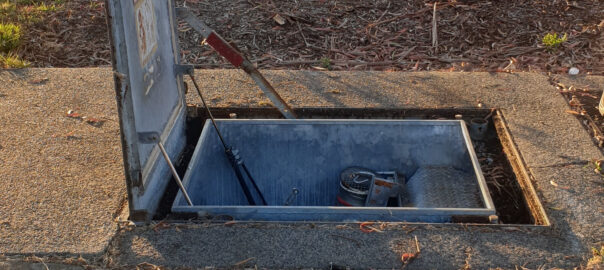A few years ago, I was out with a friend (who knows telecom history like no one else) who pointed at a patch of grass and some concrete and said “There’s an underground exchange under there”.
Being the telecommunications nerd that I am, I had a lot of follow up questions, and a very strong desire to see inside, but first, I’m going to bore you with some history.
I’ve written about RIMs – Remote Integrated Multiplexers before, but here’s the summary:
In the early ’90s, Australia was growing. Areas that had been agricultural or farmland were now being converted into housing estates and industrial parks, and they all wanted phone lines.
While the planners at Telecom Australia had generally been able to cater for growth, suddenly plonking 400 homes in what once was a paddock presented a problem.
There were traditional ways to solve this of course; expanding the capacity at the exchange in the nearest town, trenching larger conduits, running 600 pair cables from the exchange to the housing estate, and distributing this around the estate, but this was the go-go-nineties, and Alcatel had a solution, the Remote Integrated Multiplexer, or RIM.
A RIM is essentially a stack of line cards in a cabinet by the side of the road, typically fed by one or more E1 circuits. Now Telecom Australia didn’t need to upgrade exchanges, trench new conduits or lay vast quantities of costly copper – Instead they could meet this demand with a green cabinet on the nature strip.
This was a practical and quick solution to increase capacity in these areas, and this actually worked quite well; RIMs served many Australian housing estates until the copper switch off, many having been upgraded with “top-hats” to provide DSLAM services for these subscribers as well, or CMUX being the evolved version. There’s still RIMs that are alive in the CAN today, in areas serviced by NBN’s Fixed Wireless product, it’s not uncommon to see them still whirring away.

But in some areas planning engineers realised some locations may not be suitable for a big green cabinet, for this they developed the “Underground CAN Equipment Housing” (UCEH). Designed as a solution for sensitive areas or locations where above ground housing of RIMs would not be suitable – which translated to areas council would not them put their big green boxes on their nature strips.
So in Narre Warren in Melbourne’s outer suburbs Telecom Research Labs staff built the first underground bunker to house the exchange equipment, line cards, a distribution frame and batteries – a scaled down exchange capable of serving 480 lines, built underground.

Naturally, an underground enclosure faced some issues, cooling and humidity being the big two.
The AC systems used to address this were kind of clunky, and while the underground exchanges were not as visually noisy as a street cabinet, they were audibly noisy, to the point you probably wouldn’t want to live next to one.
Sadly, for underground exchange enthusiasts such as myself, by 1996, OH&S classified these spaces as “Confined Spaces”, which made accessing them onerous, and it was decided that new facilities like this one would only be dug if there were no other options.
This wasn’t Telecom Australia’s first foray into underground equipment shelters, some of the Microwave sites in the desert built by telecom put the active equipment in underground enclosures covered over by a sea freight container with all the passive gear.
In the US the L-Carrier system used underground enclosures for the repeaters, and I have a vague memory of the Sydney-Melbourne Coax link doing the same.
Some of these sites still exist today, and I was lucky enough to see inside one, and let’s face it, if you’ve read this far you want to see what it looks like!
A large steel plate sunk into a concrete plinth doesn’t give away what sits below it.
A gentle pull and the door lifts open with a satisfying “woosh” – assisted by hydraulics that still seem to be working.

The power to the site has clearly been off for some time, but the sealed underground exchange is in surprisingly good condition, except for the musky smell of old electronics, which to be honest goes for any network site.
There’s an exhaust fan with a vent hose that hogs a good chunk of the ladder space, which feels very much like an afterthought.
Inside is pretty dark, to be expected I guess what with being underground, and not powered.

Inside is the power system (well, the rectifiers – the batteries were housed in a pit at the end of the UECH entrance hatch, so inside there are no batteries), a distribution frame (MDF / IDF), and the Alcatel cabinets that are the heart of the RIM.
From the log books it appeared no one had accessed this in a very long time, but no water had leaked in, and all the equipment was still there, albeit powered off.
I’ve no idea how many time capsules like this still exist in the network today, but keep your eyes peeled and you might just spot one yourself!

C’mon, more photos please!
Want to see the rest of the cabinets.
I wonder if they have also fell out of favour given that powers carriers have under the telecom act to install low impact facilities without council approval these days (since ~97)
This is so cool, I’d love to see heaps more photos. (Including one from the top, looking in). Very interesting. Thanks for sharing
I think the one you are speaking about is at Holden Creek in the Eastern Suburbs
Darley — close to Bacchus Marsh Has / Had an underground Enclosure
How can I find out about buying some of the batteries mentioned? They would be suitable for a off grid solar system. I have read about people using them, but I don’t know how to go about purchasing them.
Contact me I have access to batteries
There were also underground TV Radio transmitter sites in Australia. I’ve worked on one in the Qld outback near Springsure. Tower is used of course but the rest of the site was underground. Bushfire protection.
Telstra used to build and maintain ABC SBS TV and radio sites .
Telstra Broadcasting operated a receiver site north of Port Augusta(I think it was at Moonlight) to pick up ABC-TV (ABNS-4) Pt Pirie, 150km to the south and then relay the program in a thin-line microwave link to Woomera in the SA desert. All the equipment was in a bunker with an entry (in a shed which doubled as the diesel room) covered by a screw down hatch. The site was primarily part of the Adelaide to Wommera microwave link and the broadcasting equipment just added in later. Optical fibre eventually made it all obsolete. I went there from our Adelaide base a few times in the late-70s/early-80s to service the broadcast equipment.
Very interesting, I worked in NDC NSW and never saw one of these, when I left I worked with Alcatel for a short while and never heard of them there either. I don’t doubt you it’s just I never saw or heard of one. One thing though, I don’t understand how visually audible works.
Very cool 😎
Interesting piece of Telecom Australia history.
I worked on 100 line country ARK crossbar exchanges in Tasmania as a TIT. These were small buildings probably about 4 metres square which housed the equipment racks, MDF and battery banks. These were generally located away from houses and by the side of the road
Never came across an underground installation, thus I found your expose fascinating.
Ben Baker
Oh come on! Surely you took heaps of photos, let’s see them!!!!!
Very cool anyway.